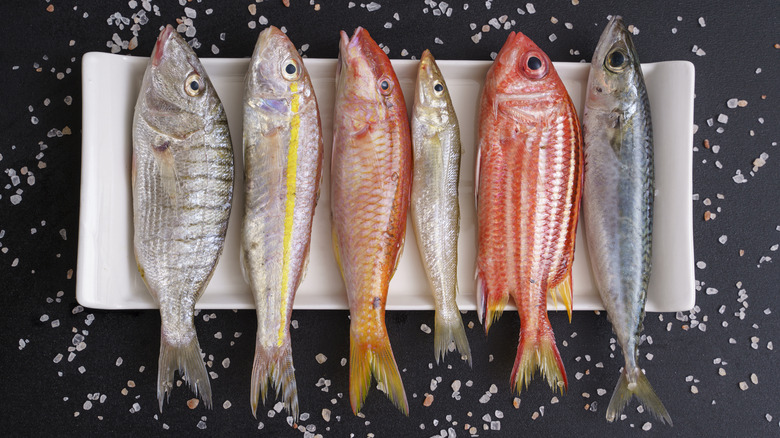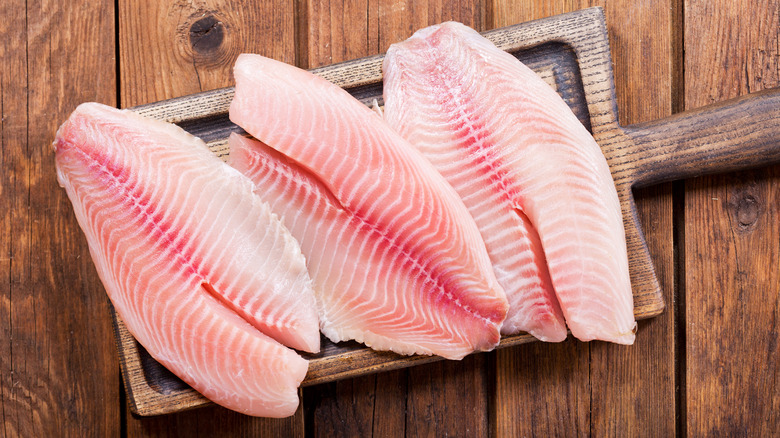What Chef Eric Ripert Looks For When Picking Out The Freshest Fish
Starting with fresh fish is arguably the single most important factor in determining whether your golden beer battered fish and chips or salmon en papillote with persillade will impress or flop. Bad fish is bad fish, and if it is past its prime, there really is not a thing you can do about it, no matter the recipe. That is where advice from professionals like chef Eric Ripert comes in. For him, making a great dish is not just about the cooking and serving — it starts with buying great ingredients from the start.
Now, there is no single, simple hack for determining how fresh fish is. You just have to use your senses, but once you figure out what to look, feel, and smell for, you will be well on your way to purchasing the freshest seafood every time. Your nose is actually one of your very best tools when you shop for fish at groceries and markets. As counterintuitive as it seems, fish should not actually smell strongly of fish, or at least not like the intense, off-putting, fishy odor you might associate with the unfortunate little guys that got washed up on the beach and are now the literal opposite of fresh.
According to Ripert, fish should smell like "sea breeze" — salty, delicate, and pleasant (via The Today Show). Yes, it might still smell faintly like fish, because it is indeed fish, but the scent should be attractive, like clean ocean air.
How to buy whole fish
The eyes are the window to the soul ... and also one of the most important indicators of whether that fish in the glass case is actually fresh. Chef Eric Ripert says that the eyes should be crystal clear. It should look like that fish could actually see you — you know, if it were alive. Rest in peace. Avoid whole fish whose eyes are recessed, cloudy, or shriveled in any way.
Ripert also suggests taking a look at the gills. If you are able to, gently lift the little flap on the fish's head to take a peak. If you can't, ask the fishmonger to do so. The gills should be bright pink or red. They should look and feel damp but should not be sticky.
That being said, touch is also a useful tool for determining freshness, so do not be shy about getting in there if you are shopping at a market where that is appropriate (you can always ask the fishmonger if you are not sure). The flesh of the fish should be taut and firm and readily bounce back when you poke it. While you are at, inspect the fins and tail to make sure they are not dry or brittle, and feel that the scales are firm and closely knit.
How to buy fish filets
Eric Ripert starts with the color when determining if a fish filet is fresh. For white fish — such as cod, bass, snapper, and tilapia — look for bright flesh with a translucent look to it. If there are bloodlines visible, they should be bright red instead of a dull brick or grayish color.
For salmon, Ripert says to take a look at the lines of fat that stripe the filets. They should be a vibrant white color, not muted or gray. Expect to see more visible fat in farm-raised salmon when compared to wild-caught, but both are good choices! Salmon fished in the wild will likely be leaner.
For all fish filets, avoid anything that looks mushy, dry, or has a white film, which can be a sign that the fish is drying out. Also, be on the lookout for any pieces that are flaking apart, especially along the edges where the filet was cut. This is known as gaping, which can be an indication that the fish was not handled gently or that it went through undesirable temperature changes while it was being stored.
If the options just are not looking great, don't be afraid to turn to the frozen section. Ripert definitely recommends high-quality frozen fish over low-quality fresh fish. In that case, look for the labels Frozen at Sea (FAS) or Individually Quick-Frozen (IQF) — both indicate that the product was frozen shortly after being caught.



